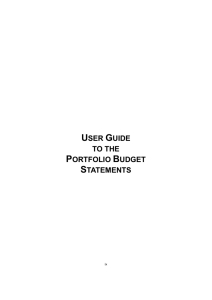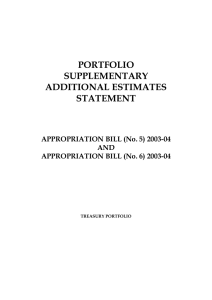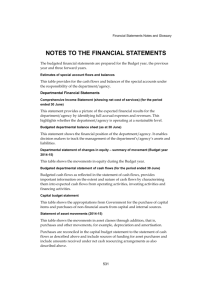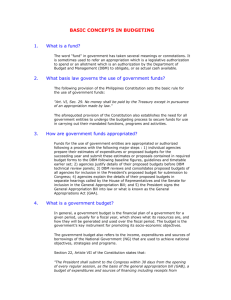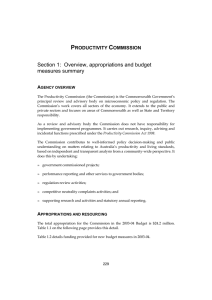Portfolio agency name - Department of Health
advertisement
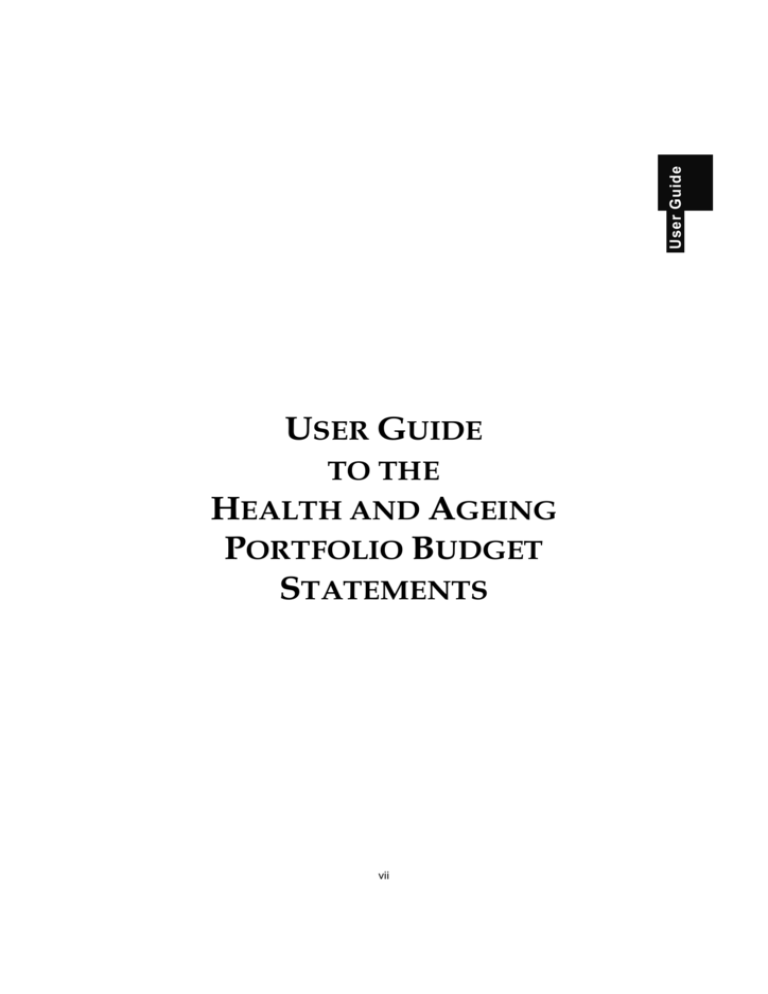
User Guide USER GUIDE TO THE HEALTH AND AGEING PORTFOLIO BUDGET STATEMENTS vii viii USER GUIDE Purpose of the Health and Ageing Portfolio Budget Statements The purpose of the 2012-13 Health and Ageing Portfolio Budget Statements (PB Statements) is to inform Senators and Members of Parliament of the proposed allocation of resources to Government outcomes by agencies within the portfolio. Agencies receive resources from the annual appropriations acts, special appropriations (including standing appropriations and special accounts), and revenue from other sources. A key role of the PB Statements is to facilitate the understanding of proposed annual appropriations in Appropriation Bills No. 1 and No. 2 2012-13. In this sense, the PB Statements are Budget related papers and are declared by the Appropriation Acts to be ‘relevant documents’ to the interpretation of the Acts according to section 15AB of the Acts Interpretation Act 1901. The PB Statements provide information, explanation and justification to enable Parliament to understand the purpose of each outcome proposed in the Bills. The PB Statements also contribute to, and support, organisation development and performance in the portfolio agencies by identifying the Government’s key strategic priorities for the year ahead. In addition, the PB Statements are used by the Department of Health and Ageing and the portfolio agencies to align their annual business plans and performance reporting with the Government’s strategic priorities. As required under section 12 of the Charter of Budget Honesty Act 1998, non-general government sector entities are not consolidated into the Commonwealth general government sector fiscal estimates and accordingly, these entities are not reported in the PB Statements. ix User Guide User Guide User Guide Structure of the Portfolio Budget Statements The 2012-13 Portfolio Budget Statements are consistent with the format and structure used in 2011-12 and are presented in three sections, aligned in several ways to the Budget Papers, as outlined below. User Guide An introduction, explaining the purpose of the Health and Ageing Portfolio Budget Statements, the structure of the document, and styles and conventions used. Portfolio Overview A brief high-level overview outlining the Portfolio’s responsibilities, structure and outcomes, and the resources available. Agency Resources and Planned Performance (Budget Statements) For each Portfolio agency (including the Department of Health and Ageing), a Budget Statement is presented in three sections: Part Description Section 1: Overview and Resources This section includes up to three components (where applicable): 1.1: Strategic Direction Statement; 1.2: Agency Resource Statement; and 1.3: Budget Measures. The intention of this section is to provide readers with an overview of the functions and responsibilities of the agency, the resources available, and where applicable, Budget measures in summary form. The Strategic Direction Statement identifies the major ongoing and new functions of the agency, and any significant challenges that will impact on the agency’s performance against its Outcome(s) over the medium-term. The Agency Resource Statement illustrates all available resources over the Budget year, including annual and special appropriations, and special account aggregates. The Budget Measures highlight new Government decisions taken since the tabling of the last set of appropriation bills, generally at Additional Estimates. It includes measure titles and estimates for the current year (2011-12), the Budget year (2012-13) and forward years (2013-14 to 2015-16). The information is to reflect the information covered in Budget Paper No.2, with the Outcome and Program against which the measures are to be pursued included to improve cross-referencing. x Section 2: Outcomes and Planned Performance This section includes two components: Outcome reporting; and Program reporting. The intention of this section is to provide readers with details of the agency’s Outcomes and Programs, its resourcing, deliverables and key performance indicators. Outcome reporting: outlines the strategies the agency will implement over the Budget and forward years to achieve the intended results specified in the respective Outcome Statement, including major projects and initiatives. The Outcome Budgeted Expenses and Resource statement provides an overview of the total expenses for the Outcome by Program. Program reporting: focuses on the objective of the Program, its resourcing, the deliverables it produces and the key performance indicators of its progress. The distinction between the production of deliverables and the measurement of the key performance indicators is to split the reporting of agency activities from the results and impacts. The aim of Program reporting is to improve the transparency of Government spending and performance, as Programs represent the primary means by which agencies address and achieve Government Outcomes. Section 3: Explanatory Tables and Budgeted Financial Statements This section includes two components: 3.1: Explanatory Tables; and 3.2: Budgeted Financial Statements. The intention of this section is to provide readers with financial accounting information about the agency’s operations over the Budget and three forward years. It also provides a reconciliation between total agency resources and Outcome attribution, and indicates the planned movements in administered funds, special account flows and Indigenous expenditure. Reporting requirements for budgeted financial statements differ between agencies (for example, according to whether the agency participates in administered transactions). Therefore, not all agencies are required to report against all schedules. The budgeted financial statements contain the estimates prepared in accordance with the requirements of the Government’s financial budgeting and reporting framework, including the principles of the Australian Accounting Standards and Interpretations issued by the Australian Accounting Standards Board (AASB), as well as Finance Minister Orders (FMOs). They show the planned financial performance for the 2012-13 Budget year and each of the forward years from 2013-14 to 2015-16. The statements also include the estimated actual for 2012-13 for comparative purposes. Glossary and Financial Statements Notes Explains key terms and financial tables xi User Guide User Guide User Guide Appropriations in the Accrual Budgeting Framework In the accrual budgeting framework, separate annual appropriations are provided for: departmental appropriations: representing the Government’s contribution to the net cost of services; departmental capital appropriations: for the acquisition of newer replacement non-current assets; administered expense appropriations: for the estimated administered expenses relating to an existing outcome, a new Outcome or a Specific Purpose Payment to the states and territories; and administered capital appropriations: for increases in administered equity through funding non-expense administered payments. Special appropriations fund the majority of payments from the Consolidated Revenue Fund (especially those that are entitlement driven or involve transfers to state and territory governments). The appropriation framework is discussed further in the introduction to Budget Paper No. 4, Agency Resourcing 2011-12. xii
